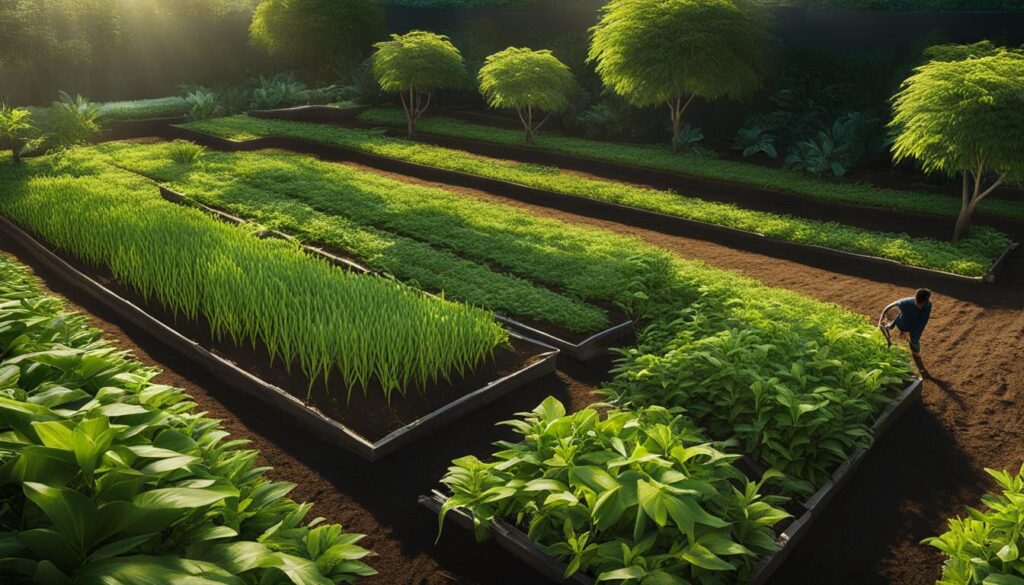Tongkat Ali, also known as Long Jack or Eurycoma longifolia, is a medicinal plant native to Southeast Asia. It is highly valued for its aphrodisiac, anti-inflammatory, and anti-cancer properties. In this guide, I will provide expert tips and techniques for successfully cultivating Tongkat Ali in your own backyard.
Key Takeaways:
- Choose a well-drained location with full sun and high humidity for growing Tongkat Ali.
- Prepare the soil by removing weeds and adding organic matter for improved fertility and drainage.
- Plant Tongkat Ali seeds directly in the soil or start them in seed trays before transplanting.
- Regular watering and mulching can help ensure optimal growth and moisture retention.
- Harvest Tongkat Ali roots after 5-7 years and process them for medicinal use.
Choosing the Right Location for Growing Tongkat Ali
Tongkat Ali, or Eurycoma longifolia, is a tropical plant that requires specific growing conditions to thrive. When selecting a location for cultivating Tongkat Ali, it is important to consider factors such as sunlight, humidity, and soil quality.
The first step in choosing the right location is to ensure that the area receives full sun. Tongkat Ali requires at least 6-8 hours of direct sunlight daily to grow and develop properly. This can be achieved by selecting a spot in your garden that is not shaded by trees or buildings.
In addition to sunlight, Tongkat Ali requires high humidity levels to flourish. Consider planting the herb in an area with naturally high humidity, such as near a body of water or in a location where there is limited wind exposure.
Furthermore, Tongkat Ali grows best in well-drained soil with a slightly acidic to neutral pH level. You can test the soil’s pH using a soil testing kit, and if necessary, amend the soil with organic matter, such as compost or well-rotted manure, to improve its fertility and drainage.
By choosing a location that provides the optimal growing conditions of full sun, high humidity, and well-drained soil, you can lay the foundation for successful Tongkat Ali cultivation.

Preparing the Soil for Tongkat Ali Cultivation
Proper soil preparation is crucial for successful Tongkat Ali cultivation. Before planting, it is important to ensure that the soil is free from weeds and unwanted vegetation. Clear the area of any debris and remove any invasive plants that may compete with Tongkat Ali for nutrients and space. This initial step will create a clean and fertile environment for the growth of your Tongkat Ali plants.
Next, it is recommended to loosen the soil to improve its structure and drainage. This can be done using a garden fork or a tiller, gently breaking up any compacted areas. Loosening the soil will allow the roots of the Tongkat Ali plants to penetrate easily and establish a strong foundation.
Amending the soil with organic matter is also essential for Tongkat Ali cultivation. Adding compost or well-rotted manure will enrich the soil with nutrients and improve its fertility. Incorporate the organic matter thoroughly into the soil, ensuring an even distribution. This will provide the necessary nutrients for the growth and development of your Tongkat Ali plants.
Table: Recommended Soil pH Levels for Tongkat Ali
| Soil pH Level | Optimal Range for Tongkat Ali Cultivation |
|---|---|
| Acidic | 5.5 – 6.5 |
| Neutral | 6.0 – 7.0 |
It is important to note that Tongkat Ali thrives in slightly acidic to neutral soil conditions. The recommended pH range for optimal cultivation is between 5.5 and 7.0. Testing the soil pH and adjusting it if necessary will ensure that your Tongkat Ali plants have the ideal growing conditions.
Planting and Caring for Tongkat Ali Plants
Growing Tongkat Ali successfully requires careful planting and attentive care. Here are some essential tips and techniques to help you cultivate healthy and thriving Tongkat Ali plants.
1. Planting Tongkat Ali Seeds
Tongkat Ali seeds can be directly sown into the prepared soil or started in seed trays and transplanted later. Ensure the seeds are planted about half an inch deep into the soil, leaving enough space between them for proper growth. Keep the soil consistently moist, especially during the germination period. Once the seedlings have developed a few leaves, you can carefully transplant them into their final growing location.
2. Ensuring Adequate Watering
Regular watering is crucial for the healthy growth of Tongkat Ali plants, particularly during dry periods. Aim to keep the soil evenly moist, but avoid overwatering, as excessive moisture can lead to root rot. Mulching around the base of the plants can help retain moisture, suppress weed growth, and regulate soil temperature.
3. Providing Proper Nutrients
Tongkat Ali plants benefit from a nutrient-rich soil. Before planting, amend the soil with organic matter such as compost or well-rotted manure to improve fertility. Additionally, consider using a balanced organic fertilizer during the growing season to provide essential nutrients. Be cautious not to over-fertilize, as excessive nutrients can negatively impact the plant’s growth.
4. Pruning and Maintenance
Pruning is essential to maintain the shape and size of Tongkat Ali plants. Remove any dead or damaged branches to promote healthy growth. Regularly inspect the plants for pests and diseases, and take appropriate measures to control them. Additionally, consider providing support, such as stakes or trellises, to prevent the plants from bending or collapsing under their own weight.
By following these tips and providing proper care, you can cultivate thriving Tongkat Ali plants in your garden. Remember to monitor their progress, address any issues promptly, and enjoy the rewards of growing this valuable medicinal herb.

Harvesting and Utilizing Tongkat Ali’s Medicinal Properties
Tongkat Ali, also known as Long Jack or Eurycoma longifolia, is a medicinal plant with numerous health benefits. The roots of Tongkat Ali are particularly sought after for their medicinal properties. Harvesting the roots at the right time is crucial to ensure maximum potency and effectiveness.
Typically, Tongkat Ali roots are harvested when the plant reaches maturity, which is usually after 5-7 years of growth. During this time, the roots develop a strong concentration of active compounds, including quassinoids and bioactive peptides, which contribute to its therapeutic effects. To harvest the roots, carefully dig up the plant, making sure to minimize damage to the roots.
Once the roots are harvested, they need to be cleaned and dried before they can be processed into various forms for medicinal use. The drying process helps preserve the active compounds and enhances the shelf life of the Tongkat Ali roots. After drying, the roots can be ground into a fine powder or used to produce extracts, which can then be utilized in traditional medicine or as dietary supplements.
“The medicinal properties of Tongkat Ali make it a valuable herb in traditional medicine. It has been used for centuries to improve sexual function, boost energy levels, and enhance overall well-being.”
When using Tongkat Ali for its medicinal properties, it is important to follow recommended dosage guidelines and consult with a healthcare professional. Tongkat Ali supplements are available in various strengths and forms, and it is essential to choose a reputable brand that adheres to quality standards.
| Tongkat Ali | Medicinal Properties |
|---|---|
| Aphrodisiac | Enhances sexual function and libido |
| Anti-inflammatory | Reduces inflammation and pain |
| Anti-cancer | Potential to inhibit cancer cell growth |
| Testosterone booster | Increases testosterone levels |
In summary, Tongkat Ali is a valuable medicinal plant with a variety of health benefits. Harvesting the roots at the right time, cleaning and drying them properly, and utilizing them in different forms can maximize the medicinal properties of Tongkat Ali. Whether used in traditional medicine or as dietary supplements, Tongkat Ali can be a powerful tool for enhancing overall well-being and promoting optimal health.

Conclusion: Growing Tongkat Ali Successfully
Growing Tongkat Ali can be a rewarding and fulfilling experience for gardeners interested in cultivating medicinal plants. By following the expert tips and techniques outlined in this guide, you can create the ideal growing conditions for your Tongkat Ali plants and ensure their successful cultivation.
Remember that choosing the right location is crucial for Tongkat Ali cultivation. Opt for a well-drained area with full sun and high humidity to provide the optimal environment for growth.
Preparing the soil properly is also key. Clear any weeds or unwanted vegetation, loosen the soil, and amend it with organic matter to enhance fertility and drainage.
Once you have planted your Tongkat Ali seeds, it’s important to care for them diligently. Regular watering, especially during dry seasons, and mulching to retain moisture and suppress weeds are essential for healthy plant growth.
After patiently nurturing your Tongkat Ali plants for several years, you can enjoy the fruits of your labor by harvesting the mature roots. Clean and dry the roots before processing them into various medicinal forms, such as powder or extracts, which can be used for their numerous health benefits.
Remember, with the right approach and commitment, you can successfully grow Tongkat Ali in your own backyard, unlocking the potential of this valuable herb.
